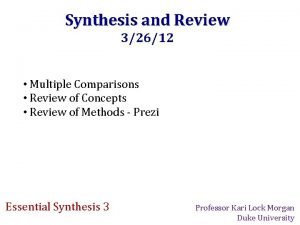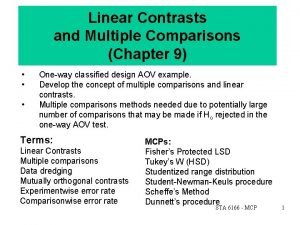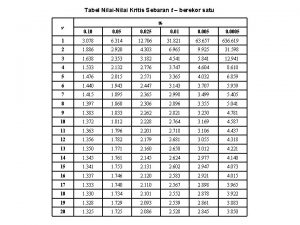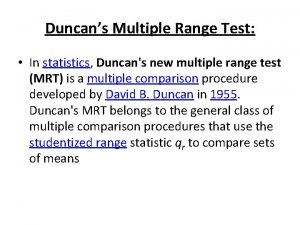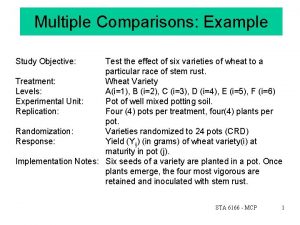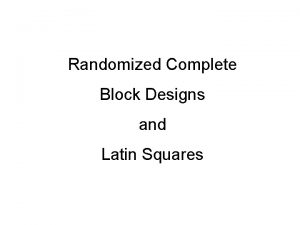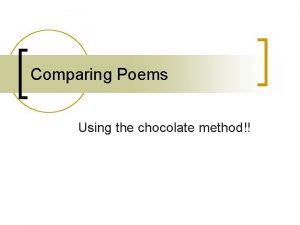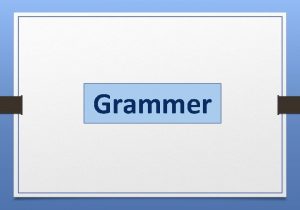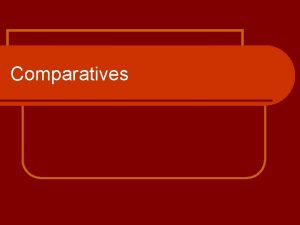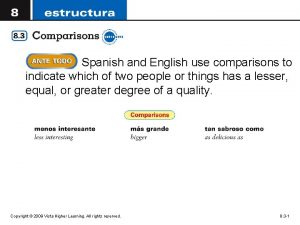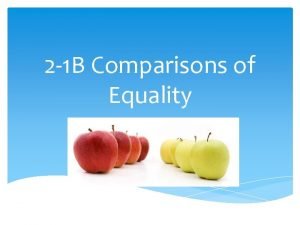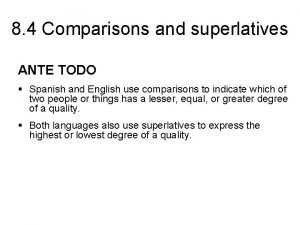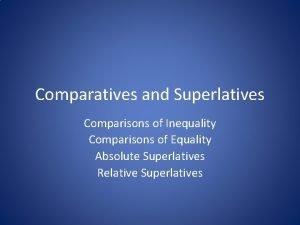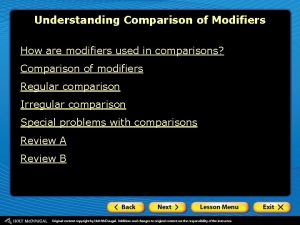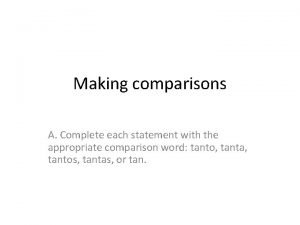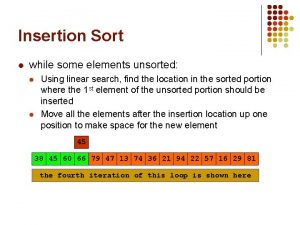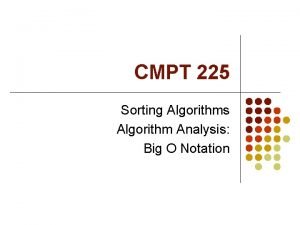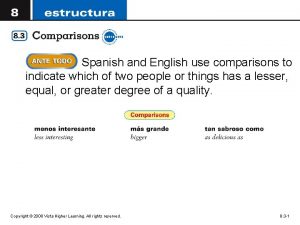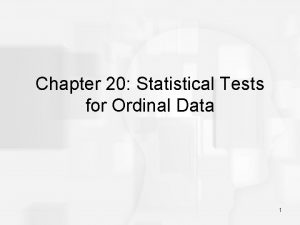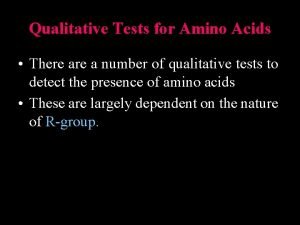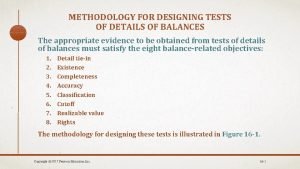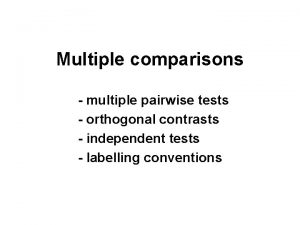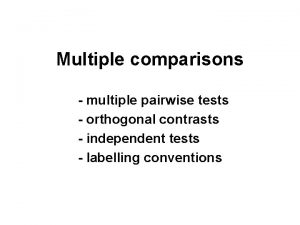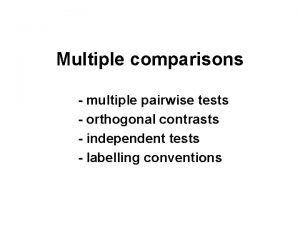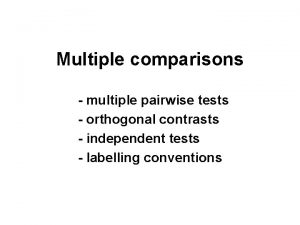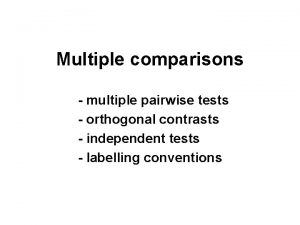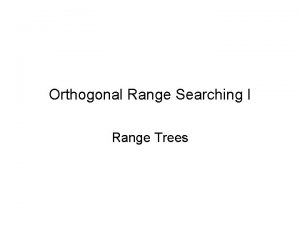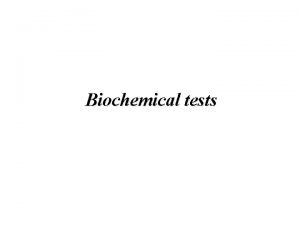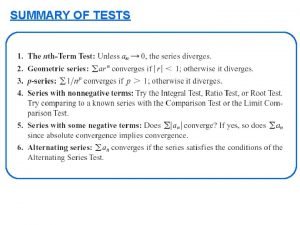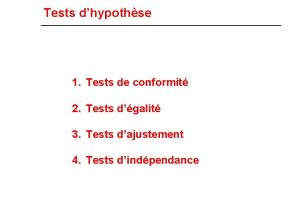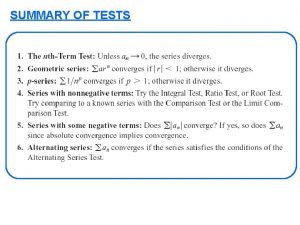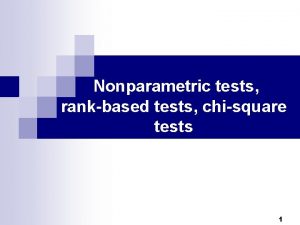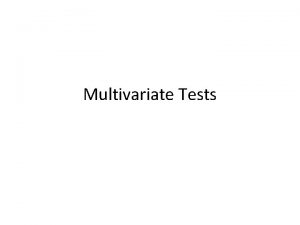Multiple Comparisons Multiple Comparisons v Multiple Range Tests







![Orthogonality ci = 0 [c 1 i x c 2 i] = 0 -1 Orthogonality ci = 0 [c 1 i x c 2 i] = 0 -1](https://slidetodoc.com/presentation_image/da7f13a9cfb8c40206bf73a1de92b693/image-8.jpg)


![S. Sq = [ ci x Yi]/[n 2 ci ] S. Sq(1) [(-1)64. 1+(-1)76. S. Sq = [ ci x Yi]/[n 2 ci ] S. Sq(1) [(-1)64. 1+(-1)76.](https://slidetodoc.com/presentation_image/da7f13a9cfb8c40206bf73a1de92b693/image-11.jpg)
![S. Sq(2) [(-1)x 64. 1+(+1) x 76. 6]2/(3 x 2) 26. 04 S. Sq(3) S. Sq(2) [(-1)x 64. 1+(+1) x 76. 6]2/(3 x 2) 26. 04 S. Sq(3)](https://slidetodoc.com/presentation_image/da7f13a9cfb8c40206bf73a1de92b693/image-12.jpg)






![S. Sq(1)= [(-3)130+(-3)124+(2)141+(2)186+(2)119]2 /n ci 2 1302/(4 x 40) = 140. 8 S. Sq(2)= S. Sq(1)= [(-3)130+(-3)124+(2)141+(2)186+(2)119]2 /n ci 2 1302/(4 x 40) = 140. 8 S. Sq(2)=](https://slidetodoc.com/presentation_image/da7f13a9cfb8c40206bf73a1de92b693/image-19.jpg)




![S. Sq(1)= [(-3)130+(-3)124+(2)141+(2)186+(2)119]2 /n ci 2 1302/(4 x 40) = 140. 8 S. Sq(2)= S. Sq(1)= [(-3)130+(-3)124+(2)141+(2)186+(2)119]2 /n ci 2 1302/(4 x 40) = 140. 8 S. Sq(2)=](https://slidetodoc.com/presentation_image/da7f13a9cfb8c40206bf73a1de92b693/image-24.jpg)












































- Slides: 68

Multiple Comparisons

Multiple Comparisons v. Multiple Range Tests ØTukey’s and Duncan’s v. Orthogonal Contrasts

Orthogonal Contrasts

AOV Orthogonal Contrasts

Tukey’s Multiple Range Test

Consider that cultivars A and B were developed in Idaho and C and D developed in California v Do the two Idaho cultivars have the same yield potential? v Do the two California cultivars have the same yield potential? v Are Idaho cultivars higher yielding than California cultivars?

Analysis of Variance
![Orthogonality ci 0 c 1 i x c 2 i 0 1 Orthogonality ci = 0 [c 1 i x c 2 i] = 0 -1](https://slidetodoc.com/presentation_image/da7f13a9cfb8c40206bf73a1de92b693/image-8.jpg)
Orthogonality ci = 0 [c 1 i x c 2 i] = 0 -1 -1 +1 +1 -- ci = 0 -1 +1 -- ci = 0 +1 -1 -1 +1 -- ci = 0

Calculating Orthogonal Contrasts d. f. (single contrast) = 1 S. Sq(contrast) = M. Sq = [ ci x Yi]2/n ci 2]

Orthogonal Contrasts - Example
![S Sq ci x Yin 2 ci S Sq1 164 1176 S. Sq = [ ci x Yi]/[n 2 ci ] S. Sq(1) [(-1)64. 1+(-1)76.](https://slidetodoc.com/presentation_image/da7f13a9cfb8c40206bf73a1de92b693/image-11.jpg)
S. Sq = [ ci x Yi]/[n 2 ci ] S. Sq(1) [(-1)64. 1+(-1)76. 6+(1)40. 1+(1)47. 8]2/ n ci 2 = 52. 82/(3 x 4) = 232. 32
![S Sq2 1x 64 11 x 76 623 x 2 26 04 S Sq3 S. Sq(2) [(-1)x 64. 1+(+1) x 76. 6]2/(3 x 2) 26. 04 S. Sq(3)](https://slidetodoc.com/presentation_image/da7f13a9cfb8c40206bf73a1de92b693/image-12.jpg)
S. Sq(2) [(-1)x 64. 1+(+1) x 76. 6]2/(3 x 2) 26. 04 S. Sq(3) [(-1)x 40. 1+(+1)x 47. 8]2/(3 x 2) 9. 88

Orthogonal Contrasts

Orthogonal Contrasts v Five dry bean cultivars (A, B, C, D, and E). v Cultivars A and B are drought susceptible. v Cultivars C, D and E are drought resistant. v Four Replicate RCB, one location v Limited irrigation applied.

Analysis of Variance

Orthogonal Contrast Example #2 Tukey’s Multiple Range Test

Orthogonal Contrasts v Is there any difference in yield potential between drought resistant and susceptible cultivars? v Is there any difference in yield potential between the two drought susceptible cultivars? v Are there any differences in yield potential between the three drought resistant cultivars?

Orthogonal Contrasts
![S Sq1 313031242141218621192 n ci 2 13024 x 40 140 8 S Sq2 S. Sq(1)= [(-3)130+(-3)124+(2)141+(2)186+(2)119]2 /n ci 2 1302/(4 x 40) = 140. 8 S. Sq(2)=](https://slidetodoc.com/presentation_image/da7f13a9cfb8c40206bf73a1de92b693/image-19.jpg)
S. Sq(1)= [(-3)130+(-3)124+(2)141+(2)186+(2)119]2 /n ci 2 1302/(4 x 40) = 140. 8 S. Sq(2)= [(-1)130+(+1)124]2 /n ci 2 62/(4 x 2) = 4. 5 S. Sq(Rem) = S. Sq(Cult)-S. Sq(1)-S. Sq(2) 728. 2 -140. 8 -4. 5 = 582. 9 (with 2 d. f. )

Analysis of Variance

Partition Contrast(rem)

Analysis of Variance

Alternative Contrasts
![S Sq1 313031242141218621192 n ci 2 13024 x 40 140 8 S Sq2 S. Sq(1)= [(-3)130+(-3)124+(2)141+(2)186+(2)119]2 /n ci 2 1302/(4 x 40) = 140. 8 S. Sq(2)=](https://slidetodoc.com/presentation_image/da7f13a9cfb8c40206bf73a1de92b693/image-24.jpg)
S. Sq(1)= [(-3)130+(-3)124+(2)141+(2)186+(2)119]2 /n ci 2 1302/(4 x 40) = 140. 8 S. Sq(2)= [(-1)130+(-1)124+(-1)141+(4)186+(-1)119]2 /n ci 2 2302/(4 x 20) = 661. 2 S. Sq(Rem) = S. Sq(Cult)-S. Sq(1)-S. Sq(2) 728. 2 -140. 8 -661. 2 = -73. 8 (Oops !!!) (with 2 d. f. )

Orthogonality c 1 i = 0 ( c 2 i = 0 ( [c 1 i x c 2 i] = 0 (- -3) + (+2) = 0 = -1) + (-1) + (+4) + (-1) = 0 = 3)(-1)+(-3)(-1)+2(4)+2(-1) =10 =

More Appropriate Contrasts

Analysis of Variance

Conclusions v Almost all the variation between cultivars is accounted for by the difference between cv ‘D’ and the others. v The remaining 4 cultivars are not significantly different. v Orthogonal contrast result is exactly the same are the result from Tukey’s contrasts.

Conclusions v Important to make the “correct” orthogonal contrasts. v Important to make contrasts which have “biological sense”. v Orthogonal contrasts should be decided prior to analyses and not dependant on the data.

Orthogonal Contrasts v Four Brassica species (B. napus, B. rapa, B. juncea, and S. alba). v Ten cultivars ‘nested’ within each species. v Three insecticide treatments (Thiodan, Furidan, no insecticide). v Three replicate split-plot design.

Analysis of Variance

Species and Treatment Means

Orthogonal Contrasts

Orthogonal Contrasts

Analysis of Variance

Species x Treatment Interaction

Species x Contrast (1)

Species x Contrast (2)

Orthogonal Contrasts and Interactions v Consider a cross classified factorial design with 4 replicates. v Four cultivars; 2 from Idaho and 2 from California (again). v 3 herbicide treatments; No-treatment control, Killall, and Onllik.

Orthogonal Contrasts and Interactions Cultivar Control Killall Onllik Total Ida. Best 90 168 147 405 Ida. Cream 75 141 135 351 Yuppy 45 64 75 184 Total 210 373 357

Orthogonal Contrasts and Interactions v Contrasts for cultivars? v. Idaho v California (-1 -1 +2), v. SS(Id v CA) = 2, 787; v Contrast for herbicides? v. Herbicide v No-treatment control (-2 +1 +1), v. SS(Herb v Not) = 1, 779; v Contrast for the interaction between the first two contrasts?

Orthogonal Contrasts and Interactions Genotype Herb Yield Ida. Best Cont 90 Ida. Best Killall 168 Ida. Best Onllik 147 Ida. Cream Cont 75 Ida. Cream Killall 141 Ida. Cream Onllik 135 Yuppy Cont 45 Yuppy Killall 64 Yuppy Onllik 75 ID v CA Herb v Not Interaction

Orthogonal Contrasts and Interactions Genotype Herb Yield ID v CA Ida. Best Cont 90 -1 Ida. Best Killall 168 -1 Ida. Best Onllik 147 -1 Ida. Cream Cont 75 -1 Ida. Cream Killall 141 -1 Ida. Cream Onllik 135 -1 Yuppy Cont 45 +2 Yuppy Killall 64 +2 Yuppy Onllik 75 +2 Herb v Not Interaction

Orthogonal Contrasts and Interactions Genotype Herb Yield ID v CA Herb v Not Ida. Best Cont 90 -1 -2 Ida. Best Killall 168 -1 +1 Ida. Best Onllik 147 -1 +1 Ida. Cream Cont 75 -1 -2 Ida. Cream Killall 141 -1 +1 Ida. Cream Onllik 135 -1 +1 Yuppy Cont 45 +2 -2 Yuppy Killall 64 +2 +1 Yuppy Onllik 75 +2 +1 Interaction

Orthogonal Contrasts and Interactions Genotype Herb Yield ID v CA Herb v Not Interaction Ida. Best Cont 90 -1 -2 +2 Ida. Best Killall 168 -1 +1 -1 Ida. Best Onllik 147 -1 +1 -1 Ida. Cream Cont 75 -1 -2 +2 Ida. Cream Killall 141 -1 +1 -1 Ida. Cream Onllik 135 -1 +1 -1 Yuppy Cont 45 +2 -2 -4 Yuppy Killall 64 +2 +1 +2 Yuppy Onllik 75 +2 +1 +2

Orthogonal Contrasts and Interactions v Contrasts for cultivars? v. Idaho v California (-1 -1 +2), v. SS(Id v CA) = 2, 787; v Contrast for herbicides? v. Herbicide v No-treatment control (-2 +1 +1), v. SS(Herb v Not) = 1, 779; v Contrast for the interaction between the first two contrasts? v. SS (Interaction) = 246.

Orthogonal Contrasts and Interactions

More Orthogonal Contrasts … Trend Analyses

Aim of Analyses of Variance v Detect significant differences between treatment means. v Determine trends that may exist as a result of varying specific factor levels.

Example #4 v Ten yellow mustard (S. alba) cultivars. v Five different nitrogen application rates (50, 75, 100, 125, and 150)

Analysis of Variance

Orthogonal Contrasts

Example #4

Example #4

Example #4

Analysis of Variance

Trend Analyses v. The F-value associates with a trend contrast is significant. v. All higher order trend contrasts are not significant.

Example #4

Linear

Quadratic

Cubic

Quartic

Example #5 v. Two carrot cultivars (‘Orange Gold’ and ‘Bugs Delight’. v. Four seeding rates (1. 5, 2. 0, 2. 5 and 3. 0 lb/acre). v. Three replicates.

Example #5

Analysis of Variance

Analysis of Variance

Analysis of Variance Orange Gold Bug’s Delight

End of Analyses of Variance Section
 Ace different tests help iq still
Ace different tests help iq still Xkcd jellybeans
Xkcd jellybeans As compared to long-range forecasts, short-range forecasts
As compared to long-range forecasts, short-range forecasts Linear contrast
Linear contrast Duncan's multiple range test table
Duncan's multiple range test table Duncan's new multiple range test
Duncan's new multiple range test Duncan's multiple range test table
Duncan's multiple range test table Duncan's multiple range test
Duncan's multiple range test Difference between rcbd and latin square design
Difference between rcbd and latin square design Contoh soal uji duncan
Contoh soal uji duncan Comparisons of adjectives and adverbs
Comparisons of adjectives and adverbs Speech involving one person
Speech involving one person Poems with comparisons
Poems with comparisons Realidades 2 capitulo 1b making comparisons
Realidades 2 capitulo 1b making comparisons Comparative of equality
Comparative of equality Parallel structure with comparisons
Parallel structure with comparisons Old comparatives
Old comparatives Tú eres (less) simpático que federico.
Tú eres (less) simpático que federico. Comparisons of equality ejemplos
Comparisons of equality ejemplos Superlative de cratered
Superlative de cratered Difficult comparative degree
Difficult comparative degree Quantifiers to make comparisons
Quantifiers to make comparisons Comparatives equality
Comparatives equality Equality comparatives
Equality comparatives Comparisons with as...as
Comparisons with as...as Make comparisons
Make comparisons Capitulo 1b making comparisons
Capitulo 1b making comparisons Which modifier can be used to make a comparison?
Which modifier can be used to make a comparison? Planned comparisons
Planned comparisons Pictures to make comparisons
Pictures to make comparisons Comparisons with as
Comparisons with as Insertion sort big o notation
Insertion sort big o notation Cmpt 225
Cmpt 225 Adverbs of the adjectives
Adverbs of the adjectives Adjective degrees
Adjective degrees Planned comparisons example
Planned comparisons example Ernesto mira más televisión que (than) alberto.
Ernesto mira más televisión que (than) alberto. Modifier
Modifier Comparative equality
Comparative equality Comparison of equality ejemplos
Comparison of equality ejemplos Internet price comparisons
Internet price comparisons Comparisons in french
Comparisons in french A priori comparisons
A priori comparisons Example of mimd
Example of mimd Multiple baseline across settings
Multiple baseline across settings Mental maths year 3
Mental maths year 3 Rob sherwood receiver test
Rob sherwood receiver test Characteristics of standardized test
Characteristics of standardized test Why is it important to test installed equipment and devices
Why is it important to test installed equipment and devices Hops history questions
Hops history questions Statistical tests for ordinal data
Statistical tests for ordinal data Wais
Wais Forensic toxicologist definition
Forensic toxicologist definition Qualitative tests for amino acids
Qualitative tests for amino acids Previous uil science tests
Previous uil science tests Projective test advantages and disadvantages
Projective test advantages and disadvantages A prayer before exam
A prayer before exam Test of detail
Test of detail Serologic tests
Serologic tests Stanag 6001 speaking examples
Stanag 6001 speaking examples Qualitative research procedures
Qualitative research procedures What is a situational judgement test
What is a situational judgement test Romeo and juliet act one quiz
Romeo and juliet act one quiz Lactobacillus colony count test
Lactobacillus colony count test Stanag 6001 listening tests
Stanag 6001 listening tests Romberga tests
Romberga tests Tutor webinar
Tutor webinar Chapter 23 specimen collection and diagnostic testing
Chapter 23 specimen collection and diagnostic testing Statistical test table psychology
Statistical test table psychology

